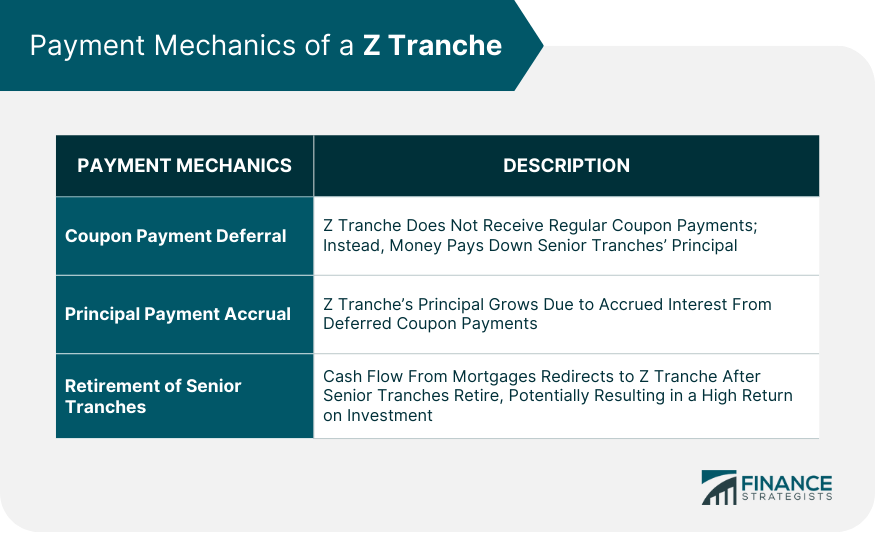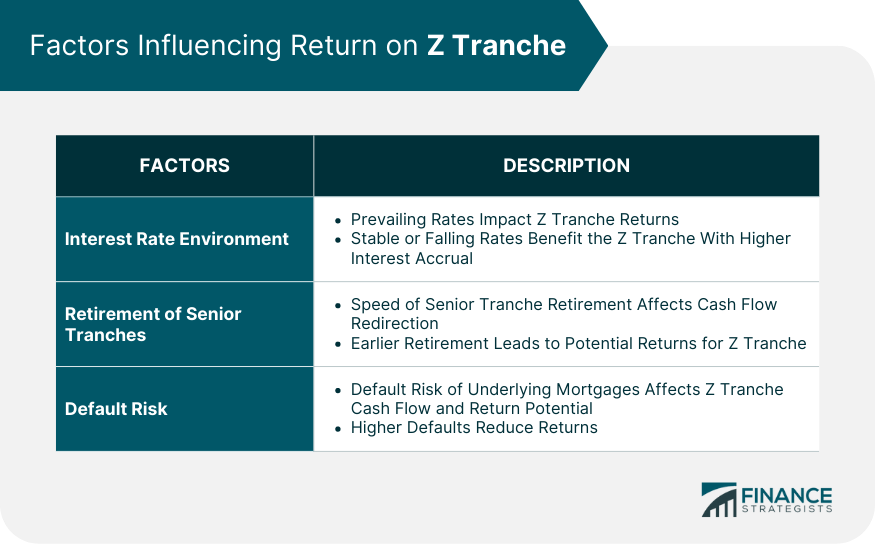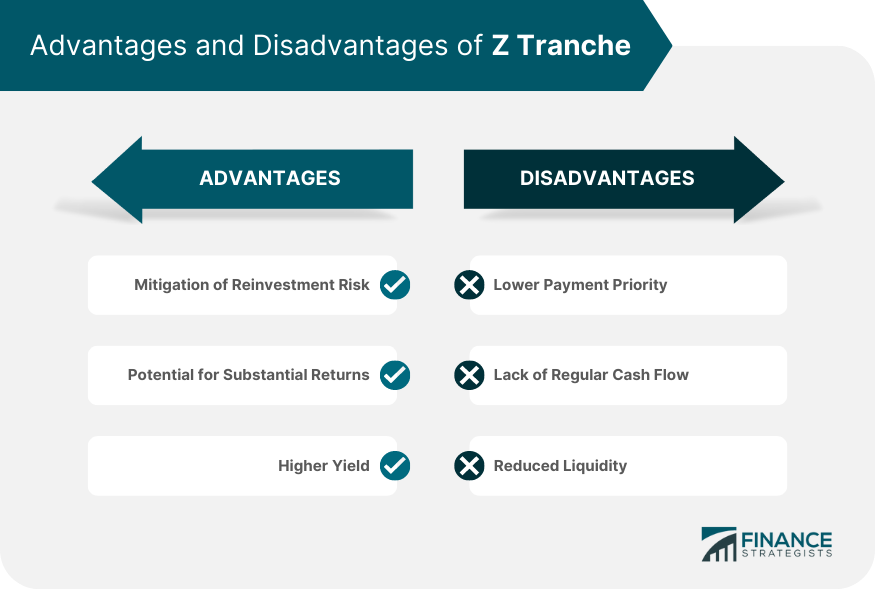The Z tranche, also known as "Z-tranche" or "accrual tranche", is the lowest ranked portion in a collateralized mortgage obligation (CMO). Unlike other tranches, it defers coupon payments to prioritize the principal repayment of higher-ranked tranches. This unique payment structure, signified by the term "accrual," leads to the accumulation of interest over time, which impacts the tranche's risk profile and potential returns. This deferment also allows the Z tranche to mitigate reinvestment risk in a declining interest rate environment, as it doesn't offer regular coupon payments. This makes the Z tranche appealing to long-term investors or those wary of reinvestment risk. Once other tranches are paid off, the Z tranche starts receiving potentially significant cash flows due to the deferred interest. Therefore, investors should understand the Z tranche's operations within the context of a CMO and its relation to other tranches. In a CMO, tranches are arranged according to the priority of payments. Usually, these securities are categorized as senior, mezzanine, and equity or Z tranches. The senior tranches have the highest priority, receiving payments before the other tranches, followed by the mezzanine tranches. The Z tranche, being at the bottom of the hierarchy, only starts receiving payments after the senior and mezzanine tranches have been fully paid off. While the Z tranche may seem less attractive due to its position in the hierarchy, its role is integral to the structure of a CMO. The deferred interest payments from the Z tranche are used to pay down the principal of higher-ranking tranches faster. During this period, the principal of the Z tranche increases because it is accruing, but not receiving interest. Thus, the Z tranche serves as a supporting structure, facilitating the faster payment of the higher tranches. Despite not receiving cash flows initially, the Z tranche is not devoid of returns. The accrued interest compounds over time, increasing the principal amount of the Z tranche. This process continues until the other tranches are retired. Therefore, even though the Z tranche may not provide immediate income, it has the potential for substantial returns over the long term due to this accruing interest. The defining characteristic of a Z tranche is the deferral of coupon payments. While the other tranches in the CMO receive regular coupon payments, the Z tranche does not. Instead, the money that would have been used for these payments is directed toward paying down the principal of the senior tranches. With the deferred coupon payments, the Z tranche's principal value gradually increases due to the accrued interest. This mechanism provides a potentially substantial return for Z tranche investors when the cash flow starts being directed towards the Z tranche after the retirement of the senior tranches. The retirement of senior tranches is a significant event for the Z tranche. When the senior tranches are retired, the cash flow from the underlying mortgages is redirected to the Z tranche. As the Z tranche has accrued interest throughout the life of the senior and mezzanine tranches, its principal has grown significantly. The cash flow directed to the Z tranche at this stage can result in a high return on the original investment, depending on the specifics of the CMO and the broader interest rate environment. The Z tranche, with its unique structure, has a distinct way of managing reinvestment risk. Reinvestment risk refers to the potential of a decline in interest rates, which can lower the returns from reinvesting the cash flow from an investment. Since the Z tranche defers coupon payments, this risk is inherently mitigated. By the time cash flows are directed to the Z tranche, substantial interest has been accrued, providing an opportunity for substantial returns, even in a lower interest rate environment. The structure of the Z tranche is designed for long-term investment horizons. Given that the Z tranche does not receive any cash flows until the senior and mezzanine tranches are retired, investors need to be comfortable with not receiving any returns for potentially a considerable period. However, the accrued interest over this period can lead to significant returns when the cash flow is redirected to the Z tranche, rewarding patient investors with a long-term perspective. Several factors can influence the return on a Z-tranche investment: The prevailing interest rate environment plays a significant role in the return potential of the Z tranche. A stable or falling interest rate environment generally benefits the Z tranche, as it allows for higher interest accrual over time. The speed at which the senior and mezzanine tranches are retired impacts the timing of cash flow redirection to the Z tranche. The sooner the senior tranches are retired, the earlier the Z tranche starts receiving payments and potentially generating returns. The default risk of the underlying mortgages in the CMO structure can affect the cash flow and, consequently, the return on the Z tranche. Higher default rates can lead to reduced cash flows to the Z tranche, impacting its overall return potential. It's essential for investors to evaluate these factors and assess their potential impact on the return profile of the Z tranche before making investment decisions. Mitigation of Reinvestment Risk: By deferring coupon payments, the Z tranche addresses the risk of reinvesting cash flows at potentially lower rates. Potential for Substantial Returns: The accruing interest over the long term can result in significant returns when the Z tranche starts receiving cash flows after the retirement of higher-ranking tranches. Higher Yield: As the lowest tranche in the hierarchy, the Z tranche typically offers a higher yield to compensate for the additional risk and deferred payments. Lower Payment Priority: The Z tranche carries a higher risk of losses in the event of mortgage defaults since it is the lowest-ranked tranche in the CMO structure. Lack of Regular Cash Flow: Investors who require regular income may find the Z tranche less suitable, as it does not provide regular coupon payments until the senior tranches are retired. Reduced Liquidity: The long-term nature of the Z tranche makes it less liquid compared to higher-ranking tranches, potentially limiting the ability to sell the investment quickly. The Z tranche, also known as the accrual tranche, is the lowest-ranked tranche in a collateralized mortgage obligation (CMO) structure. It defers coupon payments and prioritizes the repayment of higher-ranking tranches, leading to the accrual of interest over time. The Z tranche appeals to long-term investors and those concerned about reinvestment risk. Understanding the structure and payment mechanics of the Z tranche is crucial. It plays a supporting role in the tranche hierarchy, with its principal increasing over time until the senior tranches are retired. While it offers advantages such as mitigating reinvestment risk and the potential for substantial returns, there are disadvantages like lower payment priority and reduced liquidity. To make informed investment decisions regarding the Z tranche, seeking wealth management services or consulting with financial professionals is recommended. They can provide tailored advice and guidance based on individual investment goals and risk tolerance.What Is Z Tranche?
Structure of a Z Tranche
Tranche Hierarchy in CMOs
Role of Z Tranche in the Hierarchy
How Z Tranche Accrues Interest
Payment Mechanics of a Z Tranche
Coupon Payment Deferral
Principal Payment Accrual
Retirement of Senior Tranches

Risk and Reward of Investing in a Z Tranche
Reinvestment Risk and Z Tranche
Long-Term Aspect of Z Tranche
Factors Influencing Return on Z Tranche
Interest Rate Environment
Retirement of Senior Tranches
Default Risk

Advantages of Z Tranche
Disadvantages of Z Tranche

Final Thoughts
Z Tranche FAQs
A Z tranche is a lowest-ranked tranche in a collateralized mortgage obligation (CMO) structure, deferring coupon payments and accruing interest until higher-ranking tranches are retired.
The Z tranche accrues interest over time as the coupon payments it would have received are used to pay down the principal of higher-ranking tranches.
Advantages include the potential for substantial returns, mitigation of reinvestment risk, and higher yield compared to other tranches.
Risks include lower payment priority, potential losses in case of defaults, lack of regular cash flow, and reduced liquidity compared to higher-ranking tranches.
Investors with a long-term investment horizon and those who do not require immediate income, such as pension funds or insurance companies, are often suitable for investing in Z tranches.
True Tamplin is a published author, public speaker, CEO of UpDigital, and founder of Finance Strategists.
True is a Certified Educator in Personal Finance (CEPF®), author of The Handy Financial Ratios Guide, a member of the Society for Advancing Business Editing and Writing, contributes to his financial education site, Finance Strategists, and has spoken to various financial communities such as the CFA Institute, as well as university students like his Alma mater, Biola University, where he received a bachelor of science in business and data analytics.
To learn more about True, visit his personal website or view his author profiles on Amazon, Nasdaq and Forbes.











